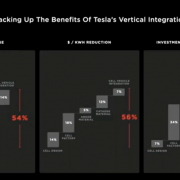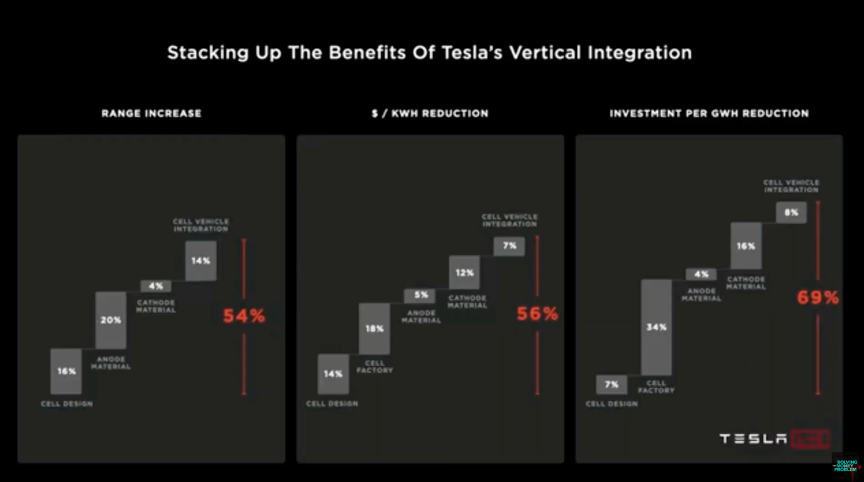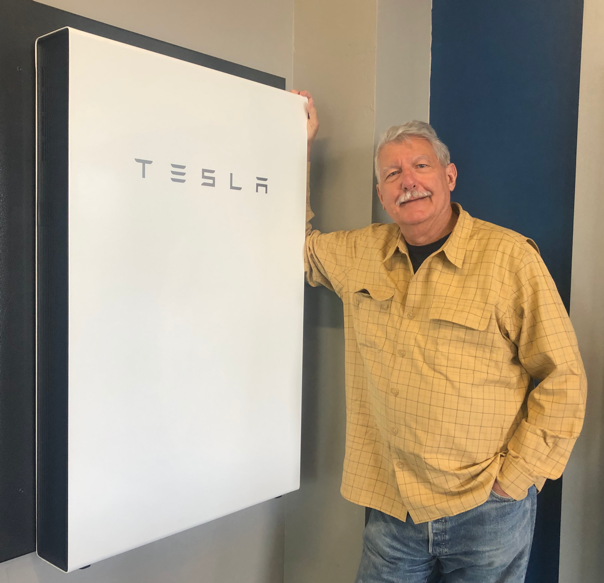I have to admit that I have been buying into Elon Musk’s vision since I first met him more than 20 years ago, back in his PayPal days. He could see how the future would unroll for the next 50 years.
That has delivered the best investment of my lifetime, with my Tesla shares (TSLA) up 151X from my initial $16.50 cost.
Thanks to Elon, my home is now completely grid-independent, with 59 solar panels and three 13.5-watt Tesla Powerwalls. I am only connected to PG&E so I can sell them my excess power at afternoon peak prices. In the mornings, I recharge my batteries. That’s a cool thing to have when your local utility completely shuts off power for six days a year.
So it was with some enthusiasm that I attended Tesla’s annual shareholder meeting and Battery Day.
Elon Musk was there with all his swagger and confidence in front of a giant screen. The audience was limited to those sitting in Teslas to enable social distancing, and when they approved, they honked horns instead of clapping.
It was a noisy event.
The past five years have been hottest on record. Climate change is accelerating, so the time to step up the move to a truly sustainable grid is here. It is nothing less than a matter of survival of the species. As Musk spoke, pictures of San Francisco's recent orange days, when you could see 100 feet, flashed up on the screen. A hundred-fold increase in our efforts is called for.
The good news is that 76% of the new electricity generation built this year will be wind and solar, or 32 GW. In 2010, 46% of electricity was coal-generated. Today it is half. Trump promises to rescue the industry came to nothing.
Even if 100% of new electricity generation comes from alternatives, it would take 25 years to convert the entire national grid. There is not enough time left to accomplish this to avoid environmental catastrophe.
The three legs of the future of power are solar power, solar storage, and electric cars.
Tesla has made a major contribution so far in all of these, with over 1 million electric cars produced, 26 billion electric car miles driven, 5 GWh of stationary batteries installed (I have 40.5 Watts), and 17 terawatt-hours of solar power generated.
The Shanghai Tesla factory went from a pile of dirt to mass production in an amazing 15 months, and that facility will soon be doubled in size.
“Tera is the new giga,” said Elon. A terawatt is 1,000 times more power than a gigawatt.
The world needs 10 terawatt-hours of new battery production a year to transition the global car fleet to all-electric in 15 years. We need 1,600 fold growth in battery efficiencies to convert the entire grid to electric. That means we need 25 terawatt-hours a year for 15 years. That is Tesla’s goal.
Tesla’s present Nevada Gigafactory is producing only 1.5 terawatt-hours a year in batteries. Would need 135 more factories to meet the above demand with current technology.
To achieve this, Tesla needs to make cars cheaper. The cost per kilowatt is not improving fast enough.
Tesla’s current plan to cut battery costs by half working by improving every one of the dozens of steps of production.
The newest battery design brings 6X increase in energy density levels, will begin mass production in a year in Fremont. Interestingly, Musk relied on existing paper and mottle mass production as models. The design is too complex to describe here but is brilliant. It’s easier to understand with the graphics found in the YouTube video below.
Down the road, dry electrodes will bring further 10X improvement in power. New machine designs and processes will bring a 7X improvement in output. Tesla’s plan is to achieve a further 75% improvement in the cost of production. The eventual goal is to make Tesla the best manufacturer on earth.
By 2022, Tesla will see a 100 GWh production increase in batteries and 3 terawatt-hours by 2030. That is a 30-fold jump.
Silicon is the most abundant element in the world after oxygen and will be used to replace existing graphite chemistry. Moving from processed silicon to raw silicon will deliver cheaper anodes and an 18% cheaper battery. Cathodes will use nickel-manganese allowing an 80% cost reduction.
Some 100% of batteries are now recycled, will eventually become sole source of raw materials for new batteries. Thus, it will become a super-efficient closed cycle.
Tesla will also reduce car costs by casting the battery as a single piece of the car body. The aircraft industry first accomplished this with fuel tanks during WWII. This alone would eliminate unnecessary 370 parts.
The next upgrade in design and manufacturing will take three years to implement and deliver a 69% reduction in cost creating a “compelling” $25,000 car that is fully autonomous and will not need maintenance.
This chops the lifetime cost of Teslas by half when compared to conventional gasoline-powered engines. If Musk can deliver on this promise, General Motors (GM) and Ford Motors (F) are toast.
Tesla is also developing a new supercar. The Tesla Plaid Model S will have a 520-mile range, go from zero to 60 miles per hour in under two seconds, and offer a positively bestial 1100 horsepower motor. You can order yours at the end of 2021. No price was mentioned, but my guess is somewhere north of $250,000.
I already have the Model X with “ludicrous” mode that catapults from 0 to 60 in 2.9 seconds and just that presents a major whiplash risk.
After the event finished, it was clear that the stock market was not drinking the Kool-Aide, Tesla shares diving 5%. It turned out to be a big “buy the rumor, sell the news” event. When traders hear the words “long-term” they glaze over and run a mile.
We may need to wait for the next cycle of upgrades and product announcements to achieve a true upside breakout.







